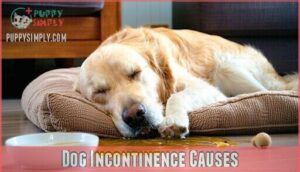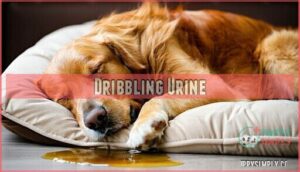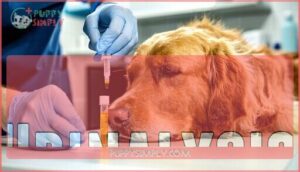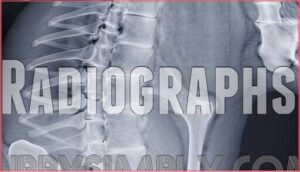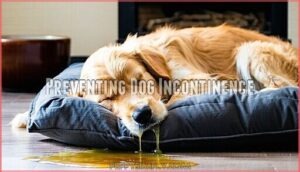This site is supported by our readers. We may earn a commission, at no cost to you, if you purchase through links.
 If your dog’s peeing in their sleep, it might be urinary incontinence, often linked to aging, urinary tract infections, or hormonal changes.
If your dog’s peeing in their sleep, it might be urinary incontinence, often linked to aging, urinary tract infections, or hormonal changes.
You’ll notice wet spots on their bedding or dribbles of urine when they move. It’s not their fault—it’s a medical issue that needs attention.
A vet can run tests, like a urinalysis or X-rays, to figure out what’s going on. Treatment could include medication, using doggie diapers, or, in some cases, surgery.
Meanwhile, make certain they stay hydrated and get regular potty breaks during the day. Curious about ways to manage or prevent this? Stick around for expert tips!
Table Of Contents
- Key Takeaways
- Dog Incontinence Causes
- Normal Urine Patterns
- Clinical Signs of Incontinence
- Diagnosing Urinary Incontinence
- Treatment Options Available
- Managing Dog Incontinence
- Preventing Dog Incontinence
- Frequently Asked Questions (FAQs)
- When should I be concerned about my dog’s incontinence?
- Why did dogs pee on bed all of a sudden?
- What are the signs and symptoms of dog incontinence?
- Are there any home remedies for dog incontinence?
- Are there any lifestyle changes that can help manage incontinence in dogs?
- How can I tell if my dog needs medical attention for their incontinence?
- Can anxiety or stress cause nighttime urination in dogs?
- How does diet impact urinary health in dogs?
- What are the signs of overhydration in dogs?
- Are specific breeds more prone to nighttime urination?
- Conclusion
Key Takeaways
- Keep an eye out for wet spots on bedding or dribbles of urine during rest—it’s usually a sign of incontinence caused by aging, UTIs, or hormonal changes.
- Consult your vet to identify the cause with tests like urinalysis or radiographs and to explore treatment options such as medications, doggie diapers, or surgery.
- Increase bathroom breaks, ensure proper hydration, and use moisture-wicking bedding to manage nighttime accidents better.
- Act quickly if you notice consistent leaks, discomfort, or behavioral changes in your dog, as this requires prompt medical attention.
Dog Incontinence Causes
When your dog starts peeing in their sleep, it’s often a sign of underlying issues affecting bladder control.
Sleep accidents in dogs often signal underlying bladder control issues, highlighting the need for prompt attention and compassionate care.
Common causes include aging, hormonal changes, urinary tract infections, or other medical conditions that impact urinary health, particularly those that affect urinary health.
Aging and Incontinence
As dogs age, they face changes that affect bladder control, leading to incontinence.
Muscle weakness, cognitive decline, and hormonal changes all play a role.
Senior dog wetting is common, but manageable with proper care.
- Reduced muscle strength weakens bladder control.
- Cognitive decline impacts bathroom habits.
- Age-related hormonal shifts increase risk.
- Decreased mobility delays bathroom breaks.
- Senior dog care boosts quality of life.
Urinary Tract Infections
Urinary tract infections (UTIs) can make dog incontinence worse, especially if you’re noticing chronic UTIs or UTI symptoms like excessive licking or accidents.
Urinary infections often lead to dog peeing in sleep. Diagnostic testing, like urinalysis, helps pinpoint the issue.
Prompt treatment prevents antibiotic resistance and keeps your dog comfortable. Address UTIs quickly to support their health.
Hormonal Imbalance
A hormonal imbalance can weaken your dog’s bladder control.
Spayed female dogs often experience spay incontinence due to low estrogen and progesterone levels.
Here’s how hormones play a role:
- Estrogen Deficiency: Weakens bladder sphincter tone.
- Testosterone Levels: Lower in neutered males, but less common.
- Hormone Therapy: Supplements can help.
- Prevention: Early hormone replacement therapy supports bladder health.
Other Medical Conditions
When other medical conditions like kidney disease, Cushing’s disease, diabetes mellitus, or spinal injuries come into play, incontinence can follow.
Bladder stones or urinary tract infections may cause leakage, while neurological issues disrupt bladder control.
These problems require prompt veterinary attention to pinpoint causes and begin treatment, often improving symptoms and helping regain your dog’s comfort and quality of life by treating underlying conditions.
Normal Urine Patterns
A healthy dog’s urination habits offer valuable clues about their overall well-being. You’ll want to keep an eye on urine color, frequency, volume, and consistency for any changes.
Normal dog urine is pale yellow and clear, not cloudy or dark. Most dogs urinate three to five times daily, though breed variations and size may affect this. Larger breeds might produce higher volumes, while smaller dogs release less.
Hydration plays a huge role in dog urine patterns. Drinking enough water helps maintain the urinary system’s health and flushes out toxins. Watch for dehydration signs, like darker urine or infrequent trips.
Regular bathroom breaks guarantee their bladder stays healthy. Understanding these patterns helps you spot trouble early and support your dog’s urinary health. A dog’s age can affect their pee-holding capacity, with puppies needing more frequent breaks, which is crucial for their urinary health and overall development.
Clinical Signs of Incontinence
You might notice small wet spots on your dog’s bedding or floor, especially after they’ve been resting or sleeping.
Small wet spots after resting could signal underlying incontinence issues—prompt action ensures your dog’s comfort and urinary health.
Sometimes, they may dribble urine while walking or seem unaware it’s happening.
Urine Leakage
You might notice small wet spots on your dog’s bed or floor.
This urinary leakage often happens during rest, leaving your pup unaware.
Canine sleep wetting varies in severity, impacting odor control and potentially causing skin irritation.
Persistent leakage can disturb sleep routines and affect your dog’s confidence.
Monitoring leakage severity helps manage dog incontinence effectively while reducing social impact and discomfort.
If the dog is a puppy, consider that bladder capacity increases with age, which can help with dog incontinence and improve overall sleep routines.
Bedwetting
Bedwetting in dogs, or nocturnal enuresis, happens when they leave wet spots during sleep, unaware of the leakage.
Nighttime accidents are common in both senior and spayed female dogs. Factors like weakened bladder muscles or hormone changes play a role.
To manage sleep incontinence, consider these bedwetting solutions:
- Use moisture-wicking pet bedding for comfort.
- Regular outdoor potty breaks before bedtime.
- Consult your vet for treatment options.
Dribbling Urine
Urine dribbling often appears as small leaks, especially after your dog finishes peeing or when walking.
This post-urination dribble might leave wet fur behind, and your dog may seem unaware.
Mild leaks can also happen during rest.
If you notice this involuntary urine leakage in your dog, it’s a common sign of urinary incontinence that requires attention.
Diagnosing Urinary Incontinence
To figure out why your dog is peeing in their sleep, your vet will start with a urinalysis to check for infections or other issues.
They might also use radiographs and a physical exam to spot any abnormalities or underlying health problems.
Urinalysis
To understand a dog urinary problem, urinalysis is often the first step in a veterinary diagnosis.
By collecting a urine sample through methods like free catch or catheterization, vets assess for a urinary tract infection or other issues.
Urinalysis types guarantee diagnostic accuracy, interpreting results to spot abnormalities, and it’s affordable and critical when addressing incontinence concerns in dogs.
Radiographs
Radiographs are a key tool your vet uses to uncover hidden causes of dog incontinence.
They help detect bladder stones, pinpoint anatomic abnormalities, and visualize tumors or injuries within the urinary system.
By providing a clear picture of underlying medical conditions, radiograph findings guide treatment for your dog’s urinary problem, ensuring a better plan to address their needs effectively.
Sometimes, straining can also indicate canine constipation issues, which may require separate evaluation.
Physical Exams
A vet consultation for a dog health issue like urinary incontinence includes physical exams to assess underlying causes.
Palpation techniques help identify bladder abnormalities, while a prostate examination checks for enlargement.
Neurological assessment and reflex evaluation reveal nerve-related problems.
Sphincter tone tests measure control effectiveness, and these veterinary diagnostics offer essential insights into your dog’s incontinence, guiding treatment options and improving overall well-being.
Treatment Options Available
There are several treatment options to help manage incontinence in dogs, including medications, management techniques, and surgery.
Your veterinarian can guide you in choosing the right approach based on your dog’s specific needs and health condition.
Medication
Medication can be a game-changer for canine incontinence.
Options like Proin and Incurin strengthen urethral muscles, reducing leaks. Emerging treatments such as GnRH therapy also show promise.
Know potential side effects, and talk to your vet about the right choice for your dog’s needs.
- Proin: Improves muscle tone, common for spayed females.
- Incurin: Estriol-based, aids hormone-related issues.
- GnRH therapy: For severe cases.
- Emerging treatments: Research ongoing for innovative solutions.
Management Solutions
For dog incontinence, management can ease stress for you and your pet.
Offer a clean dog bed with moisture-wicking bedding.
Doggie diapers help contain accidents while improving hygiene.
For those seeking added convenience, consider disposable absorbent garments.
Stick to a routine of frequent bathroom breaks.
Here’s a quick visual guide:
| Solution | Why It Helps | What to Use | Tips |
|---|---|---|---|
| Doggie Diapers | Prevents messes | Disposable or reusable | Change regularly |
| Clean Dog Bed | Keeps your dog comfy and dry | Waterproof covers | Wash often |
| Dietary Adjustments | Supports urinary health | Vet-approved diets | Maintain hydration |
| Environmental Modifications | Reduces anxiety and triggers | Quiet, safe spaces | Consistent surroundings |
Consistency and care make a big difference.
Surgery
Surgery for canine urinary incontinence includes options like collagen injections, colposuspension, or cystourethropexy.
These surgical procedures improve urethral control, helping reduce leakage. Though success rates are promising, surgical risks, recovery time, and cost factors should be considered.
Good post-op care, including monitoring for complications and follow-ups, is vital to guarantee success. Talk to your vet about the best surgical options, considering the importance of proper care.
Managing Dog Incontinence
You can help manage your dog’s incontinence with simple steps like regular bathroom breaks, ensuring proper hydration, and using doggie diapers.
These practical measures keep your dog comfortable while preventing accidents around the house, which is crucial for maintaining a clean and hygienic environment.
Regular Bathroom Breaks
Encouraging scheduled outings helps prevent dog bedwetting by keeping their bladder empty.
Stick to consistent timing with bathroom breaks, including a regular nighttime routine.
Use bladder training and positive reinforcement to shape better dog urination habits.
Consider positive reinforcement techniques to encourage desired behaviors.
Catching a sleeping dog pee less often means monitoring their dog bathroom breaks to fit their natural dog urination patterns, which is part of effective dog training.
Proper Hydration
After increasing bathroom breaks, focus on proper hydration.
Balanced water intake improves kidney function and creates diluted urine, which reduces irritation in the urinary system.
Monitor hydration closely, as it impacts dog urination habits and bedwetting.
hydration levels
Using Doggie Diapers
If sleep urination happens, doggie diapers offer practical dog incontinence management.
Choose the right solution by focusing on:
- Diaper Types: Reusable or disposable, depending on your needs and budget.
- Proper Fit: Guarantees comfort, preventing leaks.
- Skin Care and Hygiene: Check for irritation after use.
Dog diapers can save your dog bedding, reduce cleanup, and keep them comfortable.
You can find various products for dogs online.
Preventing Dog Incontinence
Preventing dog incontinence starts with reducing risk factors like obesity and hormonal imbalance, which can weaken bladder control.
By maintaining your dog’s urinary health with proper hydration, regular bathroom breaks, and monitoring urine patterns, you can lower the chances of accidents during sleep, which helps in managing incontinence.
Reducing Risk Factors
To reduce risks of incontinence in dogs, consider spaying at the right age, as early spaying may increase issues.
Manage your dog’s weight since extra pounds strain bladder control. Regular exercise benefits overall health and urinary tract function.
Stay alert for breed predispositions or other dog health concerns, and address aging or health conditions early through proactive dog incontinence management.
Maintaining Urinary Health
Maintaining your dog’s urinary health helps prevent incontinence. Focus on hydration strategies by ensuring clean, fresh water daily.
Consider preventative supplements to support urinary function. Balanced dietary influence can strengthen bladder health.
Regular checkups with your vet catch issues early. Simple bladder exercises, like controlled potty breaks, may help tone muscles.
Proactive care addresses dog health concerns and keeps urinary incontinence in check, with complete concepts of care, regular checkups, and proactive care being essential.
Monitoring Urine Patterns
Pay attention to your dog’s bathroom habits.
Notice frequency tracking, volume changes, or color consistency in their urine.
Odor monitoring and checking for sediment presence can reveal potential issues.
If sleep urination happens, consistent pet monitoring helps identify patterns.
These small steps support dog urinary health and let you address pet urinary incontinence early, keeping your canine’s urinary health in check with consistent monitoring and early intervention.
Frequently Asked Questions (FAQs)
When should I be concerned about my dog’s incontinence?
Watch for signs like frequent wet spots, strong urine odor, dribbling, or your dog seeming unaware.
If it’s persistent or paired with health issues like UTIs or behavioral changes, consult your vet promptly about frequent signs.
Why did dogs pee on bed all of a sudden?
Sudden bed peeing in dogs can signal stress, urinary tract infections, or hormonal changes.
Underlying conditions like diabetes or kidney issues might also be culprits.
A vet check guarantees accurate diagnosis and effective treatment.
What are the signs and symptoms of dog incontinence?
When your pup starts leaving "calling cards" like wet spots where they’ve been resting, that’s a sign of incontinence.
Other signs include dribbling urine while walking or damp fur, often unnoticed by your dog.
Are there any home remedies for dog incontinence?
You can try simple remedies like frequent potty breaks, moisture-wicking bedding, or doggie diapers.
Adding pumpkin or parsley to their diet may help, but always check with your vet before trying anything new.
Are there any lifestyle changes that can help manage incontinence in dogs?
An ounce of prevention beats a pound of cure.
Increase outdoor bathroom breaks, guarantee clean water access, and use moisture-absorbing bedding.
Regular walks help bladder control, while doggie diapers manage nighttime accidents, which can be considered a pound of cure, and following these tips can help with prevention.
How can I tell if my dog needs medical attention for their incontinence?
Watch for consistent urine dribbling, wet bedding, or accidents without your dog realizing it.
If they seem uncomfortable, excessively thirsty, or have difficulty urinating, consult your vet to rule out underlying health issues.
Can anxiety or stress cause nighttime urination in dogs?
Ironically, while dogs can’t stress about bills, anxiety or stress can still trigger nighttime urination.
Emotional strain disrupts bladder control, causing accidents.
Identifying triggers and creating a calming environment helps prevent stress-induced bathroom mishaps.
How does diet impact urinary health in dogs?
What your dog eats directly affects urinary health.
A balanced diet with adequate moisture, low sodium, and controlled mineral levels can prevent issues like stones or infections.
Always ask your vet before changing your dog’s diet.
What are the signs of overhydration in dogs?
Too much water sounds harmless, but it can spell trouble.
Symptoms of overhydration in dogs include excessive drooling, vomiting, bloating, lethargy, pale gums, and confusion.
In severe cases, seizures or breathing difficulties may occur.
Are specific breeds more prone to nighttime urination?
Certain large breeds like Labradors, Golden Retrievers, and German Shepherds are more prone to nighttime urination, especially as they age.
Hormonal changes, health conditions, and weaker bladder muscles often play a bigger role in these dogs.
Conclusion
Imagine this: your dog resting peacefully, unaware of their nighttime accidents.
If your dog’s peeing in sleep, it’s not their fault—it’s a manageable medical issue. Recognizing the signs, like bedwetting or urine dribbles, is the first step.
A vet visit can confirm causes like aging, infections, or hormonal shifts.
Treatments range from medications to lifestyle adjustments, like doggie diapers. Ensuring hydration and regular bathroom breaks helps too, and with the right approach, your furry friend will feel better soon with proper care.
- https://www.vetmed.ucdavis.edu/hospital/animal-health-topics/canine-incontinence
- https://www.mayoclinic.org/diseases-conditions/urinary-tract-infection/symptoms-causes/syc-20353447
- https://www.animalmedical.net/blog/2021/12/a-peek-at-endocrinology-canine-hormone-problems/
- https://thevets.com/blog/dog-peeing-blood/

